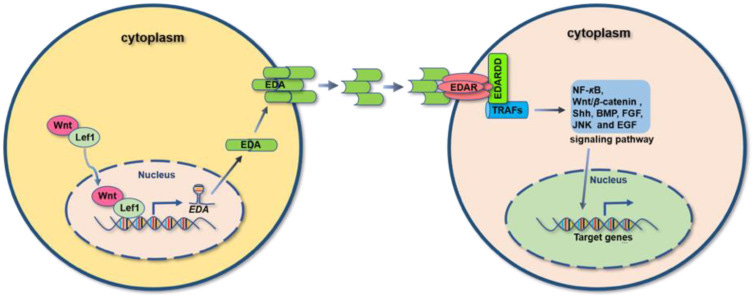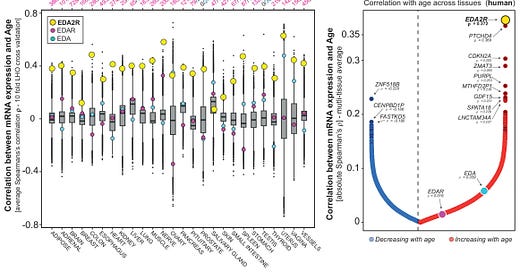Researchers untangle an important driver of the aging process
"EDA2R is a Ubiquitous Hallmark of Aging"
A new study shows that EDA2R is a “ubiquitous hallmark of aging”. This wasn't a gene/protein I had heard of, so I decided to look into the research on it.
It’s more interesting than it might seem at first glance. Stick with me here.
In the new study, the researchers set out to determine which biological process - which biomarker or protein - was upregulated throughout the body during aging. Previous studies have looked at specific tissue changes, such as what happens in the heart or brain during aging.
This new study was extensive, involving several strains of mice, many human tissue cultures, and extensive bioinformatics work with large databases.
What they found is that EDA2R (Ectodysplasin-A2-Receptor) is upregulated throughout the body in aging.
First, I'll explain what EDA2R is and previous studies on it. Then I'll discuss how it's controlled in the body. Finally, I'll tie it all back to my favorite theory of why we break down as we age - autodigestion.
What is EDA2R?
EDA2R is a receptor in the tumor necrosis factor family (e.g. TNF alpha family). It is the receptor for EDA (ectodysplasin A), which is also upregulated somewhat with aging. Ectodysplasin A is part of the TNF family and was named for its role in hair, teeth, and skin formation during fetal development.
Previous research on the EDA2R receptor shows that it is important in muscle growth and muscle wasting, the development of hair, skin, teeth, and nails, and the activation of a couple of immune system pathways. All of these tie together in a picture of aging.
In aging, the increase in EDA2R causes an increase in pro-inflammatory signaling through triggering the NF-kB pathway throughout the body. More on this in a minute.
Activation of EDA2R also causes muscle wasting, or sarcopenia, in aging and promotes cachexia (muscle atrophy) in cancer.[ref][ref]
Studies also show that EDA2R is able to induce apoptosis, which is a type of programmed cell death. Apoptosis is important in aging as a way of cleaning up unhealthy cells, including senescent cells. When the body can’t clear out senescent cells fast enough, they can build up and cause inflammation and damage to surrounding tissue. While you want to clear out senescent cells, too much apoptosis can cause excess cell death, which can lead to many health conditions, including neurodegenerative diseases and IBD.
In addition, an increase in EDA2R is linked to:
A 2016 study showed that EDA2R was the top hit for increased gene expression in the lungs of older people with COPD.[ref]
Another recent study found that increased EDA2R signaling causes muscle loss and glucose intolerance.[ref]
Higher levels of EDA2R are associated with hair loss in aging - male pattern baldness. Genetic variants that decrease EDA2R decrease the relative risk of male pattern baldness.[ref]
➝ Genetic Lifehacks article with EDA2R variants involved in balding
The opposite also holds true:
Decreasing EDA2R is protective in animal models of heart attacks by reducing NF-kB.[ref]
The new aging study showed that inhibiting EDA2R “significantly reduced the transcription of pro-inflammatory factors”[ref]
What emerges here is a picture of a single receptor that influences a bunch of things that come to mind when I think of aging — inflammation, muscle wasting, skin changes, hair loss, and cognitive decline due to neurodegeneration.
Inflammatory pathway stimulated:
EDA2R increases in response to EDA-A2. EDA stands for ectodysplasin A, which comes in two forms, A1 and A2. Both forms are coded for by the same gene (EDA), but they undergo alternative splicing to form the A1 or A2 form.
When the EDA2R receptor is activated by EDA-A2, the result is a signal that activates the NF-kB (nuclear factor kappa beta) pathway. When the NF-kB pathway is activated, NF-kB moves to the nucleus of the cell and initiates the transcription of other inflammatory genes.
Here’s an image from a good overview here:

Essentially, NF-kB very quickly cranks up inflammation in several different ways, including through increased cytokines as well as inflammatory T cells. Overactivation or dysregulation of NF-kB is a problem in rheumatoid arthritis, certain cancers, MS, IBD, atherosclerosis, and more.[ref]
To be clear, EDA2R is just one way that the NK-kB pathway is activated.
Controlling EDA2R expression:
The new study on aging biomarkers explains that EDA2R increases in response to EDA-A2. EDA stands for ectodysplasin A, which comes in two forms, A1 and A2. Both forms are coded for by the same gene (EDA), but they undergo alternative splicing to form the A1 or A2 form.
The EDA-A2 form binds to the EDA2R receptor. Increases in EDA-A2 cause an increase in the EDA2R receptor expression.
When researchers increase EDA-A2 in mice, it causes “multifocal myodegeneration”, which means the muscle breaks down and dies in multiple locations.[ref]
Another regulator of EDA2R expression is a microRNA called miR-494. MicroRNAs can bind to mRNA to block translation into the protein. In this case, miR-494 can bind to the EDA2R mRNA and prevent it from being translated into the receptor protein. MicroRNAs are one way that cells regulate how much of a protein is made from a gene (in this case, how much of the receptor protein is made from the EDA2R gene).
If you don’t have enough miR-494, you can end up with too much EDA2R. The studies on this involve inflammatory bowel diseases, like Crohn’s disease, where too much inflammation and apoptosis are occurring in the cells lining the intestines. MiR-494 regulates the amount of EDA2R, and thus, a deficiency of miR-494 leads to too much EDA2R and excess inflammation and cell death in IBD.[ref]
Is there a way to decrease EDA2R expression in aging?
Researchers are working on drugs that interact with EDA2R. It seems like a lucrative idea…
Dexmedetomidine is an anesthesia drug that inhibits EDA2R in studies, but there’s nothing currently available to inhibit EDA2R without major side effects.[ref]
I mentioned above that miR-494 modulates EDA2R and reduces protein expression. Cow’s milk (and human breast milk) contains miR-494.
Tying this to the idea of autodigestion causing aging…
I previously wrote a couple of articles (here and here) on a theory that autodigestion by pancreatic digestive enzymes is at least part of what causes aging.
In a nutshell, the powerful digestive enzymes released by the pancreas to break down food escape the intestines and break down cells throughout the body. This escape normally doesn’t occur with a healthy gut mucosal layer acting as a barrier, but with the breakdown of intestinal barrier integrity in aging, the digestive enzymes have been shown to “autodigest” organ tissue.
The studies on EDA2R being overexpressed in IBD sent me down the path of looking at the effect of increased EDA2R on the gut mucosal layer.
Mouse models of IBD clearly show that low levels of miR-494 result in increased EDA2R, which directly affects inflammation in the gut and causes damage to the epithelial barrier.[ref]
In the new study that found elevated EDA2R in aging, the researchers did show that the EDA2R (and thus inflammation) is increased in the pancreas as well as the small intestine.
EDA2R activation results in increased NF-kB activation. In models of IBD, increased NF-kB in the gut directly impacts fluid movement and loosens tight junctions in the intestinal barrier.[ref]
While definitely not definitive, I find it plausible that, in aging, elevated EDA2R causing increased NF-kB inflammatory pathway, allows for the leaking of pancreatic enzymes from the small intestine into the body, thus causing cell damage to organs.
Ending with possible solutions?
This is where I usually have several solid possible solutions… but I don’t have a lot of answers here.
Other than upregulating miR-494 through drinking milk, I can’t find any research on decreasing EDA2R.
Looking downstream at NF-kB activation, resveratrol has been shown in animal studies to decrease NF-kB and inflammatory cytokines in a model of pancreatitis.[ref]
Apigenin is another natural supplement that decreases NF-kB activation in pancreatitis.[ref]
All in all, the study's finding that EDA2R is increased throughout the body as a hallmark of aging is intriguing. It’s a topic that I’m sure I’ll come back to at some point.






sure is a delicate balance. I was interested in miR-494 (and wondered if I should have more milk), and have relied upon chatGPT to tell me more. I found it seemed to say balance was needed. "In moderation, miR-494 supports cellular repair, immune balance, and metabolic function. Too much miR-494 may impair mitochondrial function, increase inflammation, and contribute to tissue aging." Seems there is so much more to learn about when and who might benefit from stimulating or reducing this!
The more we decode EDA2R , the more we see: aging is not random, but orchestrated.
Orchestrated by genetic expression, cellular signals, and the slow breakdown of our protective barriers.